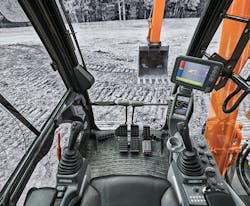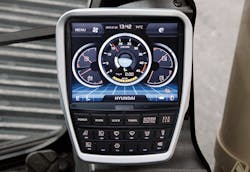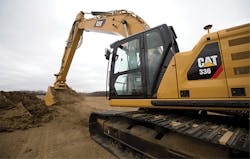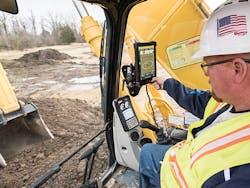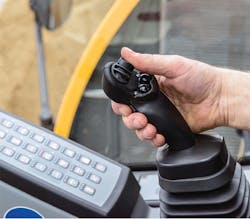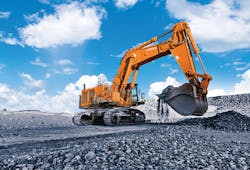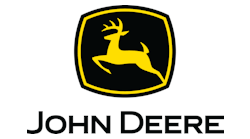Excavators are being powered by everything from grade control to telematics, and industry experts are noting an increased adoption of software on the job site.
“More than at any time in the past, contractors are data-focused,” notes Jonny Spendlove, product marketing manager of excavators for John Deere and product marketing manager of excavators for Hitachi Construction Machinery—Americas. “They want data from their machines to drive more efficiency into their business.”
“Projects get more complicated and more expensive to execute. Any bit of precision you can gain really helps to improve the timeline and workflow. It also helps to limit rework,” notes Aaron Kleingartner, spokesperson for Doosan Infracore North America, of increased implementation of grade control systems.
“Many times, what will happen is if you’re digging, you’re bringing your excavator in to excavate and have another tool to do your final grade. If you can get closer with your excavation tool, you have less work for the grader, dozer, or a compact piece of equipment to come in and do that final grade. You limit the time needed to help to improve the process and workflow.”
Another driving factor for increased adoption of the technology is that it’s being embraced by a generation of operators who are accustomed to technology, Kleingartner points out.
Telematics is becoming an industry standard, notes Todd Dohnal, dealer development manager, KOBELCO USA.
“The use of telematics reduces downtime and optimizes fuel economy,” he says. “Geo-fencing also is becoming more important, especially in certain areas with increased crime in machine theft.”
The ability to instantly produce error codes for the dealer and customer also is a significant benefit of telematics, especially because an operator may sometimes ignore error codes and continue working, Dohnal adds.
“Since these systems are proprietary to each manufacturer, companies like Trimble are working to bring a universal platform to the market to allow end-users one system and one dashboard to monitor their multi-branded fleet,” says Dohnal. “Although this won’t allow all of the detailed information that the OEM system may get, it is more than enough to assist them in making business and service decisions.”
Options abound in the marketplace.
For machine guidance, Volvo is making its Dig Assist machine control system standard on its excavators ranging from the EC220E to the EC480E.
Dig Assist is designed to help operators level sites, dig trenches, grade slopes, and create complex, multidimensional site profiles.
It is powered by the Volvo Co-Pilot in-cab tablet and incorporates sensors and GNSS technology.
Dig Assist Start includes Level, Slope, and Quick Measure and is designed to be user-friendly for new and experienced operators, notes Matt McLean, product manager at Volvo CE.
To use it, an operator touches the bucket to the ground and tells the machine the depth and angle to dig. The screen displays the distance between the bucket and the target depth, indicated by a horizontal green line, and provides a light bar to gauge how close the operator is getting with each pass.
“You don’t have to actually watch the screen while you’re working—you can simply reference how you’re doing in your peripheral,” notes McLean. “When you see blue, keep digging. If you see green, you’re on grade. If you start seeing orange or red, you’ve dug too far and need to back off.”
To use the Dig Assist Start app, an operator measures the couplers and buckets, storing them in the system. Adding buckets and other attachments allows the system to make accurate measurements while using the various features.
Once that information is entered and stored, the contractor can initiate the task.
For example, to dig a 10-foot-deep trench at a three-degree slope, a contractor sets the parameters on the slope feature.
“Touch the bucket teeth to the ground and hit 0.0 in the upper right to establish your bench,” says McLean. “Touch the dimension area and on the pull-down screen, use the arrows—or type it in using the calculator icon—to select the 10-foot depth you want to dig to.”
Next, the contractor touches the angle icon to add the three-degree slope or enter it as a percent gradient.
“Swipe up and the screen will show you how far you need to dig to hit your target. Now, start digging, The light bar will let you know when you’re getting close. If this particular job didn’t require a slope, the Level feature would allow you to maintain a consistent depth for the length of the trench,” says McLean.
The Quick Measure feature is used for those who want to calculate the values of angle and/or distance using the bucket tip. To do that, the excavator operator sets the bucket tooth on the starting point of the measurement, taps the symbol to start the measurement, moves the bucket tooth to the endpoint of the measurement—values of distances and angles follow the movement—and taps the symbol to erase the measurement.
“One of the easiest ways to use Quick Measure is to check your work,” says McLean. “For example, if you want to check that your trench is eight feet deep, tap your reference at ground level and tap various places at the bottom of your trench to confirm it’s eight feet down. If you’re digging a slope, it can measure that as well.”
Quick Measure also is handy when used in applications such as surface mining where the contractor may need to remove 10 feet of overburden, says McLean.
“With Dig Assist, you program in that you’re going to be digging 10 feet down and then you always have that target to dig to. With Quick Measure, you’ll be sure.”
By upgrading to Dig Assist 2D, contractors get additional features to enhance performance, such as the ability to program up to five layers per task, create a line to follow, and save level and slope tasks.
“The accuracy of each layer is important,” points out McLean. “Suppose you’re putting in a water line that involves multiple layers with specific requirements for each. You can set up a line representing the bottom of the trench at seven feet, then specify the layers on top: six inches of sand as the base, three and a half feet of gravel, two feet of fill soil, and one foot of topsoil.
“With Dig Assist, you can program five different layers at any given time and the Co-Pilot display will help you stay accurate for each, preventing unnecessary rework.”
Another example McLean offers of the capabilities of Dig Assist is following a line.
“Suppose you need to dig a trench and follow a line NNW for a quarter-mile. When you use ‘level’ and ‘slope,’ the machine tells you where and how far down you need to dig. When you use ‘line,’ the machine shows you where to go—such as the direction to move your machine.”
With 2D, projects can be set up and saved for more efficiencies in future jobs.
The Dig Assist In-Field Design app uses GNSS and RTK navigation technology to help contractors dig trenches and more complicated shapes in three dimensions, which can be defined on the Volvo Co-Pilot display, eliminating the need for surveyors to mark out an excavation site.
With excavators, upgrading to 3D involves running either the Topcon 3D-MC or Trimble Earthworks apps on the Volvo Co-Pilot for complex or larger projects.
Volvo is adding an On-Board Weighing app, says McLean.
Dave Adams, Sales Manager, Connected Services, Volvo Construction Equipment, points out that while data can be valuable in helping contractors track construction equipment to improve efficiency and productivity, the availability of more complex data and an onslaught of fault codes that lack useful details can create confusion for operators.
Volvo’s ActiveCare Direct was designed to provide an around-the-clock, year-round active machine monitoring program through its Uptime Center utilizing software, experienced people, and proven processes to transform traditional telematics fault codes into actionable and understandable information, he says.
Hyundai Construction Equipment is developing and applying various technologies for excavators and wheel loaders, with IT innovations including technology integration, data analysis, and modeling.
The company is now focusing on ways to integrate and expand those technologies to give contractors timely operational information and the tools they need to analyze and apply the information to their fleet management, maintenance, acquisition, and disposition decision-making processes, notes Stephen Adamczyk, district service manager, Hyundai Construction Equipment Americas.
Hyundai’s HiMATE system uses GPS technology through satellite or mobile network connectivity to monitor key machine components such as the engine, hydraulics, and electrical system at any time and in any location, says Adamczyk.
It’s designed to save contractors time and money, especially by promoting greater preventive maintenance to reduce equipment downtime, he adds.
“HiMATE allows users to view and manage operating information, select and activate alarms, and call up reports such as alarm incidents and maintenance status of a specific machine or combination of machines,” says Adamczyk. “HiMATE also supports theft prevention through such capabilities as geo-fencing and alarm notifications.”
The company integrates its systems with third-party software and information-management tools, making available the application-programming interface for HiMATE to third-party developers of worksite-management and related software products, fleet management companies with mixed fleets, and others.
“We’re also integrating a diagnostics capability into HiMATE which will include maintenance alerts and predictive parts-and-service diagnostics based on machine operating data,” says Adamczyk, adding that the goal of integrating these technologies is to give end-users the information and data management tools needed to analyze their equipment’s performance, maintenance needs, and machine life cycles.
“In construction equipment, data analytics is all about supporting the operation, understanding cost-of-ownership issues, maximizing machine performance, and achieving higher productivity and profits,” he adds.
Recent enhancements in Hyundai’s HX series excavator product line include straight-line travel, enabling the left floor pedal to be set via toggle switch for straight-forward and reverse travel, eliminating the need for an extra pedal.
Other enhancements: auto engine shutdown, standard with all key-type machines, Fine Swing and Boom Float hydraulic system modes for additional swinging precision and controllability when performing grading operations, respectively, and a full LED exterior lighting package for maximum illumination of the job site during nighttime or limited visibility conditions.
A key recent innovation is the company’s All-Around View Monitoring system, including Intelligent Moving Object Detection available on its HX series excavators and HL900 series wheel loaders.
“This safety-enhancing system helps prevent job site accidents by maximizing operator awareness of the surrounding areas, providing a 360-degree field of vision, a 3D bird’s-eye view, and a 2D/four-channel view,” says Adamczyk. “IMOD alerts the operator of a person or object within five meters or 16.5 feet of the machine.”
Hyundai has an ongoing collaboration with Trimble to provide machine control through its Trimble Earthworks system, enabling the excavator to work semi-automatically so the operator can create smooth, flat, or sloped surfaces more easily, with greater accuracy and in less time, says Adamczyk.
Doosan also has partnered with Trimble to bring Trimble Earthworks control to the operator’s experience.
“The grade control system helps to enhance the operator control of being able to not have to have a grade stake operator to check grades,” says Kleingartner. “That’s the most simple application. You can upload a 3D CAD file into the system and set limits where the machine itself will not dig too deep. Or if you need to add a little extra material because you are a little too low, it tells you exactly how much to add back in.”
By not over-digging, the machine’s efficiency is improved, he adds.
Several companies offer GPS systems that work in unison with the machine to provide accurate real-time data to map, notes Dohnal, adding that the same system can assist the operator in controlling some of the functions of the machine to ensure the grade matches the pre-programmed data.
Caterpillar has a vast offering of standard technologies designed for safety and work efficiency on its newest generation of excavators, including the 320, 323, 330, and 336.
E-Fence enables the operator to create invisible electronic boundaries over, under, and around the excavator, stopping the machine before it goes beyond those boundaries to protect people and the machine from hitting an obstruction and causing damage.
E-Fence Ceiling enables the operator to set a height limit for the boom using the in-cab monitor, automatically stopping it to avoid accidents.
E-Fence Wall sets a boundary in front of the excavator to limit the reach and prevent contact between the machine and an object located in front of it. E-Fence Floor creates a lower boundary that prevents an operator from hitting objects at or beneath ground level, such as utilities.
E-Fence Swing works to the left and right and enables an operator to set parameters so the machine doesn’t swing beyond them, notes Ryan Neal, product application specialist for Caterpillar.
“If an operator is working between two buildings and wants to make sure they don’t swing at either one of them, they can set it on the left and set it on the right and it’s going to give them a working envelope,” says Neal.
E-Fence Cab Avoidance is another Cat feature that activates an invisible barrier around the cab to prevent the bucket or other attachment from contacting the cab, impacting the operator, and damaging equipment such as the ROPP.
Lift Assist helps operators pick up heavy objects without tipping through visual and auditory alerts, which digitizes the lift chart found on the right window inside the cab, says Neal.
“It gives the operator live information, so if they are lifting a large manhole, it’s going to tell them the rated capacities the machine is at and give them an indication where they are at over the side or the front of the machine according to the lift chart,” he says.
Cat also offers 2D-indicate only depth and slope, which indicates to operators how deep they need to dig.
Cat’s Grade with Assist adds semi-autonomous digging to the standard Grade with 2D and works with the optional Grade with Advanced 2D and Grade with 3D upgrades, designed to boost efficiency up to 45%.
Grade Assist automates boom and bucket movements for more accurate cuts. The operator sets the depth and slope into the monitor, activating single-lever digging.
Cat’s upgrade offering of Grade with Advanced 2D gives operators more advanced 2D options, such as simple 2D infield designs profiling ditches and more complicated steps, says Neal.
CAT Grade with 3D integrates traditional machine control and guidance with machine hardware and software from the factory, designed to improve productivity and job safety and offer versatility.
“If 3D doesn’t work because the operator is going to be inside of a building, you can turn off the GPS antennas and work inside two-dimensionally,” says Neal. “You go back outside and get satellite reception again and are back to using 3D. You can go at any capacity and have some sort of grade at all times if needed.”
Operators can be more efficient, use less material, burn less fuel, and get jobs done more quickly, says Neal, adding that when the technology is used to its full capacity, operators can derive a 45% efficiency gain.
For those new to technology, Neal suggests incorporating a few of them into the company operations and introducing others as needed.
“The learning curve is intuitive,” he says. “We have shortcuts built into the display. As a former operator, the last thing I want to do is hit 15 buttons to make something work. Cat has a standard 10-inch monitor touchscreen. The numbers are large. The cameras are good.”
Caterpillar’s next generation of excavators also features remote troubleshooting as well as Remote Flash, which alerts operators to software updates.
KOBELCO has worked with Trimble for several years to develop an advanced control system for use on its excavators.
“All the operator has to do is raise the boom and the GPS will control the arm and bucket function to ensure the proper grade is achieved,” says Dohnal.
The system uses gyroscopic sensors similar to those used in modern airliners and stability systems on automobiles.
The system’s three levels of usage include Grade Assist, enabling the operator to monitor the position of the bucket or working tool in relation to the machine.
2D Machine Control can provide a height and/or slope reference to the operator with the assistance of a laser system and additional sensors. The system and operator can manually or automatically control the machine to recreate the programed elevations.
3D Machine Control can be manually or automatically controlled to match a 3D set designed for the groundwork with the addition of a GNSS, receivers, and pre-programmed engineering plans. With this system, multiple machines can work together to meet the engineer’s design, says Dohnal.
Improvements to hydraulics systems mean that not only can excavators now monitor and closely match engine power to hydraulic power, but they can also tailor the hydraulic flow for precision control and better fuel efficiency with two pumps, says Dohnal.
“Contractors in North America are more frequently viewing excavators not just as ‘bucket’ or ‘digging machines’ but as versatile tool carriers,” he adds. “Hydraulic thumbs, couplers, shears, hammers, and grapples can increase machine versatility and flexibility to tackle a wide variety of jobs.”
Some of the most recently engineered excavators can tailor the machine functions, vary the hydraulic flow, make pressure adjustments, and adapt the response to individual job conditions, the attachments being used, and even the operator preferences, notes Dohnal.
Another new update to the electronics is modern Engine Speed Sensing, designed to increase efficiency in present-day hydraulics by providing engine power where and when it is needed.
“Couple this with variable displacement pumps—which can take the engine up to full power with one individual pump—and performance is again increased,” he adds.
The addition of electronic proportional auxiliary circuits—which allow the operator to see flow and pressure levels from the cab—are also common, says Dohnal, adding that independent rotation circuits for rotating shears and/or tilt buckets are available for modern excavators as well.
Hybrid technology in excavators is more readily available and is becoming more popular, adds Dohnal.
“The demand for a balance of ecology, productivity, and economy is continuing to grow,” he says. “While early hybrid excavators were slower than conventional machines, the latest hybrid models are now faster than the original hybrids with the same power output and the added bonus of saving more than 20% in fuel during heavy lifting.”
Hitachi recently announced the launch of Hitachi Solution Linkage, a factory-integrated grade reference system developed in cooperation with Topcon.
“Solution Linkage works as a one-stop-shop to take the guesswork out of achieving the right grade, and it monitors in real-time so jobs can be completed quickly,” says Spendlove.
Solution Linkage is available as an option on the ZX210-6 and ZX210LC-6 as well as the ZX350LC-6 excavators.
“Electronics should make the job easier, which is why full integration is so important,” says Spendlove. “When selected, Solution Linkage is fully integrated into the machine’s cab and structures, which helps shield key components such as wire harnesses and sensors from damage. That integration also provides the operator with conveniently placed joysticks to provide effortless control.”
Hitachi’s ZXLink system comes standard equipped on most excavators. Owners can remotely access data on the fleet location, functions, hours, fuel consumption, and alerts.
“Telematics help keep fleet managers updated on maintenance checkpoints and alert them to any failures or problems that need addressing,” says Spendlove.
Some of the technology solutions that John Deere offers to help contractors be more productive, keep their machines running, and keep their costs down include Grade Guidance, JDLink, and Service Advisor Remote.
Integrated Grade Guidance is available on John Deere’s 210G, 350G, and 470G excavators, with options for 2D and 3D.
“For those customers who simply need to get to grade in an underground trenching application, 2D Grade Guidance is an efficient and affordable solution,” says Spendlove. “For contractors working on engineered jobs in site development—potentially with many slopes and curves—3D Grade Guidance is the way to go.”
JDLink—which is standard on Deere models from 130G and up—provides users with information on fuel consumption, idle time, location, and operator usage patterns, among other variables.
It also provides alerts to customers when maintenance is required or when a machine component is at risk. Dealers and factory support teams also monitor critical data points to ensure the company stays ahead of any issues and maintains outstanding product quality levels, Spendlove adds.
To address downtime issues, Service Advisor Remote allows a dealer technician—with the permission of the contractor—to see where a failure is occurring, diagnose the issue, and then pinpoint how to solve the issue.
“If a visit to the job site is required to correct the issue, the technician will have the correct parts and will understand how to get the machine up and running as quickly as possible,” says Spendlove.
CASE D Series excavators can provide faster cycle times as a result of a newly developed electronically controlled pump, a larger control valve, and multiple sensors, notes Andrew Dargatz, product marketing manager, wheel loaders, CASE Construction Equipment.
“These features combine with the CASE Intelligent Hydraulic System and its four integrated control systems to make the best use of the machine’s hydraulic power and momentum, resulting in added strength and fuel efficiency,” he adds.
The four systems comprising the CASE Intelligent Hydraulic System are: Boom Economy Control, designed to reduce RPMs by using gravity during boom down and swing; Auto Economy Control, designed to lower RPMs during idle and automatically shut down the engine after a preset idle time; Swing Relief Control, designed to reduce hydraulic power at the swing start; and Spool Stroke Control, designed to adjust hydraulic pressure during digs.
Using improvements to the Spool Stroke Control system, D Series excavators reuse hydraulic fluid whenever possible to automatically increase cycle times and efficiency.
“The operator experiences a more productive machine without losing the precision of the machine’s controls,” says Dargatz.
The D Series also provides the operator with three working modes—Speed Priority, Heavy, and Automatic—that help the machine conserve energy and exert only as much power as needed to complete the job at hand, he adds.
In Sun Valley, ID, Burks Excavation does a lot of custom homes, site work, commercial projects, subdivision work, water/sewer infrastructure, and wetland projects, as well as site preparation for paving and concrete work.
The company is kept busy keeping up with the demands of the growing area, which includes tourism and new businesses.
Bo Burks, owner of Burks Excavation, endeavors to address the challenge of determining the right fleet strategy not only for current projects but future ones as well. He’s based his strategy on the equipment needed to address his company’s typical project, which is a high-end home in tight spaces.
Among the pieces of equipment he has invested in for his fleet are the CASE CX130D and CX210D excavators as well as the CX60C mini excavator.
The mountainous terrain and loamy valley soil also pose a job site challenge, especially when the company is doing infrastructure work.
“Sometimes our sites will be on the side of the hill with other homes involved, so we’re digging not quite lot line to lot line, but pretty close,” says Burks. “By the time you excavate and do the lay back, you’re really close to the other existing homes, which becomes a challenge for access and safety.”
Burks relies on his two CASE D Series excavators for their responsiveness, smoothness, and consistency of the CASE Intelligent Hydraulic System, he says.
Four integrated control systems make the best use of the machine’s hydraulic power and momentum, resulting in added strength and fuel efficiency, says Burks.
Using improvements to the Spool Stroke Control system, D Series excavators reuse hydraulic fluid whenever possible to automatically increase cycle times and efficiency. It is designed to give the operator a more productive machine without losing the precision of the machine’s controls.
“Shortly after we got the CX210D, we started a hotel project. It was a 30,000-yard excavation and I was absolutely blown away at how fast that machine is,” notes Burks. “It’s super well-balanced. We have thumbs on all of our machines and so even with the thumb, the machine is very well balanced.
“You don’t get a lot of shake. It has a lot of good hydraulic pressure to the tracks. That’s an issue a lot of times because when you’re trying to do multiple tasks at one time, you’re moving the machine and you’re swinging, you’re moving your stick and your arm around. A lot of times the machine stops, because there’s not enough hydraulic pressure.
You don’t get any of that with the CX210D
or the CX130D.”
Burks finds fuel savings to be another benefit of the intelligent hydraulics.
“The fuel economy on the excavators has really changed our game,” he says. “It’s pretty nice when we can fuel the CX210 and I can run two hard days. We’ve put a solid 14 hours on the machine because you’re stopping during the day and the machines automatically shut off, which is another great feature to have because guys get in the habit of getting out and doing something and they forget they left the machine running.”
Kleingartner points out that the past five years have ushered in the advent of engines changing from higher emission levels to Tier IV.
“Manufacturers like Doosan and others have taken that opportunity to nbsp;really optimize the engine and hydraulic systems in excavators and they are really tailored and matched to each other very well now,” he says, adding that this is made possible with electronic controls and electronically-controlled pumps.
The two systems working in tandem provides the most efficient transfer of power to the machine’s working functions, Kleingartner points out.
“The more efficient you can be in that transfer of power, the less power you actually need to do the job at hand,” he says. “With sensing technology in the cylinders or in the load side circuit of the hydraulic system, you can tailor the engine output exactly to what is needed.”
Doosan’s D-Ecopower system is used in larger machines to adjust the engine RPM automatically to match the hydraulic system needs and output, says Kleingartner.
“That happens without any operator input,” he adds. “That’s just part of the machine and allows the operator to focus on the task.”
Doosan offers power modes—economy, standard, power, and power plus—to enable the operator to make adjustments tailored to the job’s needs.
“That gives a little extra boost when you need it or you can put it in economy if you’re doing light duty work or just loading trucks with loose-fill that doesn’t need a lot of extra power,” says Kleingartner.
“You can run that engine RPM a little lower and that allows the machine to work at a lower fuel consumption rate but still provide enough power based on the task input from the operator.”
The company also offers power modes that enable an operator to adjust the machine’s engine, work modes, and the hydraulic system.
It can be tailored to lifting cycles or attachment modes and tailor the hydraulic pressure and capabilities to exactly what the machine is intended to do, Kleingartner adds.
“You need a lot of power to pull that material out of the hole, but when you swing to the side, you don’t need that much power,” he says, “whereas when you’re lifting, you need a very precise amount of control so that your movement of the machine is a little different than when you’re just trying to dig. The work modes allow the operator to configure and set the machine to what is most efficient.”
Telematics is standard on Doosan equipment, helping operators to derive cost efficiencies through using the data to make project decisions and manage fleet maintenance, says Kleingartner.
“There are very specific things from a utilization point of view where you can use that data and make sure the machine is either making money because it’s working properly or maybe it’s indicating you need a different size machine that would be more efficient,” he adds.
Liebherr technology provides data designed to improve the operator’s experience and job site efficiency.
New Generation 8 crawler excavators use an electric over hydraulic control for the joysticks, notes Marcus Barnes, product specialist for Liebherr USA construction equipment division.
“This type of system allows for more autonomous, precise movements and makes it easier to integrate the current grade control systems on the market,” says Barnes.
Additionally, Liebherr’s LiDAT system—a wireless data transfer system that provides information about a machine’s operation and location—is available on every size excavator the company manufactures.
The LiDAT standard package supplies information about equipment deployment planning, machine positioning data, operation, use, and service intervals, while the LiDAT Plus system offers geographical and time-related monitoring of critical operating conditions and user-defined data transfer intervals.
An additional Teleservice package allows Liebherr service staff to remotely log in to the machine to analyze and fix faults and the system also provides data such as idle time, and hours on the machine, says Barnes.
Liebherr offers grade control preparation kits from Trimble and Topcon and also a preparation kit for the weighing system from Loadrite.
Liebherr has rolled out INTUSI, an intuitive user interface that connects construction machines to the Internet of Things through a modern control environment. The new concept links operation and machine intelligence and is used in all Liebherr earthmoving machines and material handlers.
Komatsu offers a lineup of intelligent, semi-automatic excavators designed to help an operator improve efficiency and accuracy when grading, including the PC210LCi, PC290LCi, PC360LCi, PC390LCi, and PC490LCi. The proprietary software solution driving the excavators is offered for the life of the machines.
“With the excavators, technology can be applied to many applications, from mass grading to trenching to utility work,” notes Ron Schwieters, product manager for Komatsu intelligent machine control and smart construction.
Komatsu software intelligence offers the full profile of the bucket, enabling the operator to know the location of its edge at all times.
“It also knows where the back of the bucket is so when the contractor is grading and moves his bucket in any position, it protects the surface from undercut,” says Schwieters. “The key activity when excavating is to not take more material than you intended to take out. A full profile of bucket can protect a user from penetrating the grade they are trying to get to.”
Schwieters points out that the technology enables contractors to gain efficiencies in several job tasks and grade with confidence, such as not having to go past grade or lose material.
Komatsu’s distributors’ local technology solution experts support contractors as they adopt the technology, especially those for whom the technology and processes are new, notes Schwieters.
“The technology solution expert is the first person on the site to give that additional onboarding training and make sure the contractor’s experience of how that machine is going to work and how to interact between all the processes around the machine is successful,” he says, adding the support is provided throughout the construction company channels as needed.
The technology solution expert also can introduce contractors to additional technologies, such as the use of drones and a 3D modeling service.
Andrew Earing, Komatsu excavator product marketing manager, points out that Komatsu offers contract solutions that provide data to support a contractor’s business such as average fuel consumption and hours on the machine, among many other parameters “they can integrate into their business to help manage their fleet and in doing so, optimize their fleet performance.”
Hitachi introduced in May the EX1200-7 excavator, the third machine in Hitachi’s new EX-7 Series lineup, following the recent launch of the EX2600-7 and EX5600-7.
The EX1200-7 is the company’s smallest mining excavator and also serves as a crossover machine for construction customers.
Available in a backhoe or shovel configuration, the EX1200-7 is Hitachi’s smallest mining excavator and also serves as a crossover machine for construction end-users, says Brian Mace, mining product marketing and applications manager, Hitachi Construction Machinery, Americas.
Hitachi’s Fuel Consumption Optimization technologies are a driving factor in improved fuel economy for the EX1200-7—6% as compared to the previous model (the EX1200-6) through engine and hydraulic system improvements.
The EX1200-7 features a Cummins EPA Final Tier 4 engine with DEF. When the machine is in neutral, auto-idle reduces engine speed to save on fuel consumption.
The new EX1200-7 also features a 4.5% increase in bucket capacity with a 7-cubic-meter (9.2-cubic-yard) capacity. Equipped with optimized swing control, the new machine also has an improved hydraulic system with a flow regeneration valve to reduce power requirements from the hydraulic system and engine.
The EX1200-7 undercarriage has three single-sided upper rollers on each side of the track frame to help maintain track shoe clearance and reduce debris buildup. Additionally, the boom and arm are welded, utilizing a full-box section design to evenly distribute stress and provide ease of maintenance. The underslung low bend configuration of the front attachment hoses removes the need for clamping to help reduce chafing and increase reliability.
A new option with the machine is the auto-lubrication system for a bulk excavation front attachment which supplies grease to the superstructure, including bucket pins. The advanced system comes redesigned with a large capacity grease tank, new grease pump, in-line grease filter, and breather with filter.
The EX1200-7 design was created for optimal frame longevity to ensure the machine withstands the demands of any operation with the cab resting on 6-point, support type, fluid-filled elastic mounts.
A center track frame delivers optimal stress dispersion to reduce the chance of failure in high-stress areas. An improved track link design also mitigates the premature failure of the master pin while oil-filled idlers and rollers eliminate the need for daily lubrication.
The pressurized cab’s climate-controlled air conditioning helps overcome environmental extremes. The operator seat was designed for the mining industry with a weight-adjusting cushioned seat enabling operators to customize suspensions settings.
Critical machine information is delivered on a large, multi-functional display fitted with an LED backlight. An optional sun visor and roll screen also help provide maximum comfort.
The EX1200-7 also provides the option of Aerial Angle, which works as a 360-degree vision system. The system notes equipment surroundings through a display monitor that combines a set of images captured by cameras positioned at different locations around the machine.
Spendlove points out that a hydraulic system plays a significant role in increased efficiency, reliability, and durability.
In 2018, Hitachi introduced the ZX345USLC-6, which features the TRIAS II three-pump hydraulic system that provides multifunctioning performance and fast cycle times. The ZX345USLC-6 also is a reduced-tail-swing excavator, enabling work to be done in tight spaces.
“When demanded, the third pump supplies additional hydraulic oil to the swing circuit without stealing oil and speed from other functions,” says Spendlove. “This hydraulic system enables an operator to maximize productivity without sacrificing fuel economy.”
John Fornfeist, operations manager, New-Com Inc. in Las Vegas, notes, “I could tell right away that the geometrics of the 345 make for a very stable machine. I also like the stick configuration and the mobility of it.
“That third pump makes it not only fast for swing control and loading our trucks, but in our area, there’s a lot of side pressure work that occurs when opening up an excavation. That third pump gives it so much power to get slopes opened up in hard material.”
